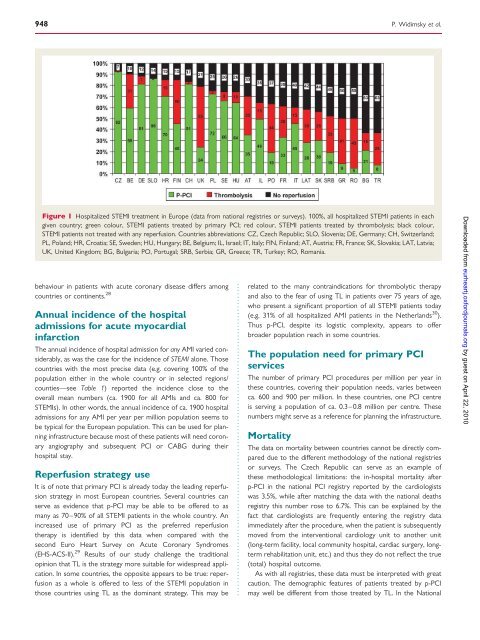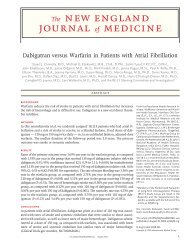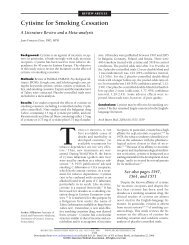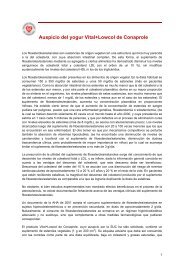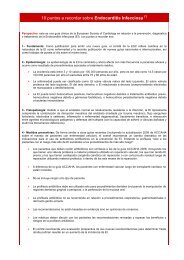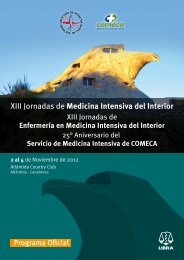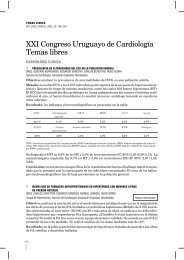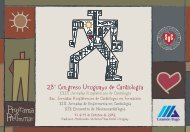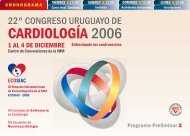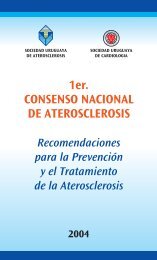Reperfusion therapy for ST elevation acute myocardial infarction in ...
Reperfusion therapy for ST elevation acute myocardial infarction in ...
Reperfusion therapy for ST elevation acute myocardial infarction in ...
You also want an ePaper? Increase the reach of your titles
YUMPU automatically turns print PDFs into web optimized ePapers that Google loves.
948<br />
P. Widimsky et al.<br />
Figure 1 Hospitalized <strong>ST</strong>EMI treatment <strong>in</strong> Europe (data from national registries or surveys). 100%, all hospitalized <strong>ST</strong>EMI patients <strong>in</strong> each<br />
given country; green colour, <strong>ST</strong>EMI patients treated by primary PCI; red colour, <strong>ST</strong>EMI patients treated by thrombolysis; black colour,<br />
<strong>ST</strong>EMI patients not treated with any reperfusion. Countries abbreviations: CZ, Czech Republic; SLO, Slovenia; DE, Germany; CH, Switzerland;<br />
PL, Poland; HR, Croatia; SE, Sweden; HU, Hungary; BE, Belgium; IL, Israel; IT, Italy; FIN, F<strong>in</strong>land; AT, Austria; FR, France; SK, Slovakia; LAT, Latvia;<br />
UK, United K<strong>in</strong>gdom; BG, Bulgaria; PO, Portugal; SRB, Serbia; GR, Greece; TR, Turkey; RO, Romania.<br />
behaviour <strong>in</strong> patients with <strong>acute</strong> coronary disease differs among<br />
countries or cont<strong>in</strong>ents. 28<br />
Annual <strong>in</strong>cidence of the hospital<br />
admissions <strong>for</strong> <strong>acute</strong> <strong>myocardial</strong><br />
<strong><strong>in</strong>farction</strong><br />
The annual <strong>in</strong>cidence of hospital admission <strong>for</strong> any AMI varied considerably,<br />
as was the case <strong>for</strong> the <strong>in</strong>cidence of <strong>ST</strong>EMI alone. Those<br />
countries with the most precise data (e.g. cover<strong>in</strong>g 100% of the<br />
population either <strong>in</strong> the whole country or <strong>in</strong> selected regions/<br />
counties—see Table 1) reported the <strong>in</strong>cidence close to the<br />
overall mean numbers (ca. 1900 <strong>for</strong> all AMIs and ca. 800 <strong>for</strong><br />
<strong>ST</strong>EMIs). In other words, the annual <strong>in</strong>cidence of ca. 1900 hospital<br />
admissions <strong>for</strong> any AMI per year per million population seems to<br />
be typical <strong>for</strong> the European population. This can be used <strong>for</strong> plann<strong>in</strong>g<br />
<strong>in</strong>frastructure because most of these patients will need coronary<br />
angiography and subsequent PCI or CABG dur<strong>in</strong>g their<br />
hospital stay.<br />
<strong>Reperfusion</strong> strategy use<br />
It is of note that primary PCI is already today the lead<strong>in</strong>g reperfusion<br />
strategy <strong>in</strong> most European countries. Several countries can<br />
serve as evidence that p-PCI may be able to be offered to as<br />
many as 70–90% of all <strong>ST</strong>EMI patients <strong>in</strong> the whole country. An<br />
<strong>in</strong>creased use of primary PCI as the preferred reperfusion<br />
<strong>therapy</strong> is identified by this data when compared with the<br />
second Euro Heart Survey on Acute Coronary Syndromes<br />
(EHS-ACS-II). 29 Results of our study challenge the traditional<br />
op<strong>in</strong>ion that TL is the strategy more suitable <strong>for</strong> widespread application.<br />
In some countries, the opposite appears to be true: reperfusion<br />
as a whole is offered to less of the <strong>ST</strong>EMI population <strong>in</strong><br />
those countries us<strong>in</strong>g TL as the dom<strong>in</strong>ant strategy. This may be<br />
related to the many contra<strong>in</strong>dications <strong>for</strong> thrombolytic <strong>therapy</strong><br />
and also to the fear of us<strong>in</strong>g TL <strong>in</strong> patients over 75 years of age,<br />
who present a significant proportion of all <strong>ST</strong>EMI patients today<br />
(e.g. 31% of all hospitalized AMI patients <strong>in</strong> the Netherlands 30 ).<br />
Thus p-PCI, despite its logistic complexity, appears to offer<br />
broader population reach <strong>in</strong> some countries.<br />
The population need <strong>for</strong> primary PCI<br />
services<br />
The number of primary PCI procedures per million per year <strong>in</strong><br />
these countries, cover<strong>in</strong>g their population needs, varies between<br />
ca. 600 and 900 per million. In these countries, one PCI centre<br />
is serv<strong>in</strong>g a population of ca. 0.3–0.8 million per centre. These<br />
numbers might serve as a reference <strong>for</strong> plann<strong>in</strong>g the <strong>in</strong>frastructure.<br />
Mortality<br />
The data on mortality between countries cannot be directly compared<br />
due to the different methodology of the national registries<br />
or surveys. The Czech Republic can serve as an example of<br />
these methodological limitations: the <strong>in</strong>-hospital mortality after<br />
p-PCI <strong>in</strong> the national PCI registry reported by the cardiologists<br />
was 3.5%, while after match<strong>in</strong>g the data with the national deaths<br />
registry this number rose to 6.7%. This can be expla<strong>in</strong>ed by the<br />
fact that cardiologists are frequently enter<strong>in</strong>g the registry data<br />
immediately after the procedure, when the patient is subsequently<br />
moved from the <strong>in</strong>terventional cardiology unit to another unit<br />
(long-term facility, local community hospital, cardiac surgery, longterm<br />
rehabilitation unit, etc.) and thus they do not reflect the true<br />
(total) hospital outcome.<br />
As with all registries, these data must be <strong>in</strong>terpreted with great<br />
caution. The demographic features of patients treated by p-PCI<br />
may well be different from those treated by TL. In the National<br />
Downloaded from eurheartj.ox<strong>for</strong>djournals.org by guest on April 22, 2010


